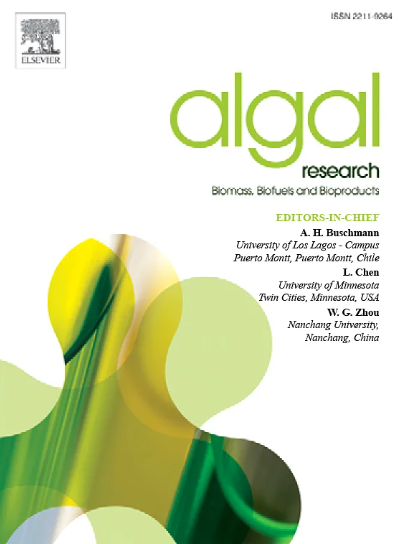Artificial intelligence-driven prediction models for the cultivation of Chlorella vulgaris FSP-E in food waste culture medium: A comparative analysis and validation of models
IF 4.6
2区 生物学
Q1 BIOTECHNOLOGY & APPLIED MICROBIOLOGY
Algal Research-Biomass Biofuels and Bioproducts
Pub Date : 2025-01-25
DOI:10.1016/j.algal.2025.103935
引用次数: 0
Abstract
Recent advancements in biotechnological processes have increasingly relied on machine learning (ML) to enhance efficiency particularly in optimizing microalgae cultivation using food waste as an alternative culture medium. This research work explores the influence of input features derived from food waste culture medium on the growth of Chlorella vulgaris FSP-E by utilizing machine learning models to predict the dry cell weight (DCW) with high precision. Significant correlations between DCW and variables such as concentration, total phosphorus (TP), total nitrogen (TN), and chemical oxygen demand (COD) were identified using scatter plot and heatmap analysis. The heatmap analysis revealed substantial positive correlations among concentration, TP, TN, and COD with DCW, underscoring the importance of these nutrients in fostering microalgae growth. Conversely, the proteins content exhibited a negative correlation with DCW, indicating their limited role in promoting biomass production. Among the machine learning models tested, the Artificial Neural Network (ANN) outperformed among other model in which the results exhibited an R2 of 0.9897, MAE of 0.0632, MSE of 0.0098, and RMSE of 0.0992, respectively. The k-Nearest Neighbors (k-NN) and Support Vector Regression (SVR) models also demonstrated strong predictive capabilities, with k-NN achieving an R2 of 0.9894, MAE of 0.0446, MSE of 0.0102, and RMSE of 0.1011, while SVR achieved an R2 of 0.9844, MAE of 0.0921, MSE of 0.0150, and RMSE of 0.1225. Optimal hyperparameters for the ANN included the activation function, hidden layer sizes, solver and learning rate of ReLu, (32, 64), lbfgs, and constant, respectively. Validation confirmed ANN superior performance, demonstrating its potential for optimizing microalgae cultivation for sustainable biofuel production. This study underscores the potential of using machine learning models to optimize biomass production in microalgae cultivation, providing valuable insights for enhancing sustainable biofuel production.

在厨余培养基中培养小球藻 FSP-E 的人工智能驱动预测模型:模型的比较分析与验证
本文章由计算机程序翻译,如有差异,请以英文原文为准。
求助全文
约1分钟内获得全文
求助全文
来源期刊

Algal Research-Biomass Biofuels and Bioproducts
BIOTECHNOLOGY & APPLIED MICROBIOLOGY-
CiteScore
9.40
自引率
7.80%
发文量
332
期刊介绍:
Algal Research is an international phycology journal covering all areas of emerging technologies in algae biology, biomass production, cultivation, harvesting, extraction, bioproducts, biorefinery, engineering, and econometrics. Algae is defined to include cyanobacteria, microalgae, and protists and symbionts of interest in biotechnology. The journal publishes original research and reviews for the following scope: algal biology, including but not exclusive to: phylogeny, biodiversity, molecular traits, metabolic regulation, and genetic engineering, algal cultivation, e.g. phototrophic systems, heterotrophic systems, and mixotrophic systems, algal harvesting and extraction systems, biotechnology to convert algal biomass and components into biofuels and bioproducts, e.g., nutraceuticals, pharmaceuticals, animal feed, plastics, etc. algal products and their economic assessment
 求助内容:
求助内容: 应助结果提醒方式:
应助结果提醒方式:


